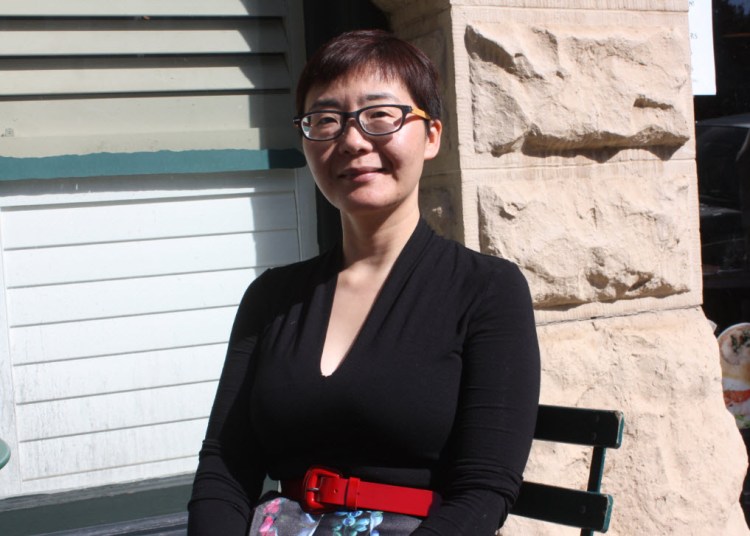VentureBeat: Inevitably people are going to be concerned about privacy at this stage. Is all you can tell them, “Well, don’t tweet as much”?
Zhou: [Laughs] No, we have to be very open about that. Let’s use health care as an example. If I’m a customer of this company, when I log in to my account, I can see what doctor’s visits I’ve gone to, the vitals from my last checkup, and so on and so forth. What we can tell people using that kind of service is, ‘You can use this tool to learn more about yourself and about how other people like you are staying healthy.’ Someone like me, I’m very busy, but I also like going out and being social. What kind of wellness program works for me? A health care provider can let me know that if I share some of this data – say, a Yelp profile and a Twitter feed.
My take on this is that for regular people like us, we can’t afford our own exclusive personal physician. We can’t afford a personal financial analyst or personal trainer. But if other people like us have had a good experience taking a certain path, we can learn more and benefit from that.
Of course, an enterprise should be very up front with the customer. ‘Would you like to share this?’ The sharing should also be largely anonymous. It’s not like I should hear, ‘Dean likes this, so you might too.’
We’ve talked to lots of companies about the pilot program, and their comments have been very similar. It’s not necessarily that they want to use this to make more money from their customers, but it comes as a side effect. If they don’t know enough about their customers, they just bombard them with inaccurate messages, and that loses them their investment in the end, because it drives customers away.
VentureBeat: It does seem like there’s an area where you definitely want to limit your capability to identify things. California is moving to restrict employers from being able to use Facebook analysis to reject somebody’s job or college application. People are just way too honest on those platforms. It almost seems like the anonymous route is a safer direction to move in a lot of ways. You can draw a lot of anonymous data about just types of people.
Zhou: Another good example, people have talked about using this for recruitment. My thinking about recruitment is that it’s not about rejection. It’s really about better placement. If I go to a company and interview, I’m always wondering, ‘Would I fit into this company?’ Every company has a very different culture. Google has a very different culture from IBM or Facebook. If you can externalize that culture to people, people will understand and say, ‘Maybe I woulnd’t really like to work here.’ I think a very transparent way of doing things will help both the individual and the company.
VB: It seems like you could do a kind of pre-screening. ‘Send me all the people who are viable candidates based on their personality.’ Then you could know how to talk to those people, know how to engage with them in a certain way.
Zhou: A somewhat extreme example, say I’m running a charity organization. I’m going to ask people to apply for a particular job in a particular cause. How weird is it if this person actually didn’t care about this cause? You’d want someone who had high levels of self-transcendence, someone interested in helping others. Someone more interested in optimizing themselves, I might not reject them outright, but I’d have to say, ‘These are the people in my organization. This is what motivates them. If your motivation isn’t in line with theirs, I don’t think you’d be happy here either.’
VentureBeat: For us, at VentureBeat, we stand on that line between journalism and blogging, where on one side you promote an opinion and on the other you don’t. If you’re in the middle, that’s not bad. But if you tilt too far to either extreme, it doesn’t really work for us. That’s probably how we would make use of it.
Zhou: In traditional social networking analysis, they talk about influencers. Someone’s that everyone is an influencer in this era now, because everyone has a voice. Certain voices are bigger or smaller, but they’re still voices. We derive what we call the network of potential. People influence people who are like them – similar people, like-minded people. If you look at different celebrities or different ordinary people, you might see someone who has only 200 or 300 Twitter followers versus someone who has as many as two million followers. If you look at the makeup of their network, even though someone might have only 200 followers, those followers could all be very alike. That means their potential influence could be much bigger, as opposed to someone with two million followers who are nothing alike. In what area does a person have influence? That’s important to think about.
VentureBeat: We’re interested in our net influence score as well, because we usually find that while are traffic is not among the highest, the influence that we have reaches into a lot of other publications. So does that kind of analysis fits well with other stuff that you’re doing, about personality and who your friends are and the like?
Zhou: This is very similar to something customers ask us for, about store branding. You want to influence people who haven’t been influenced yet, right? That’s key. Someone like Amazon.com does it in a way that’s very different. They say, ‘You just viewed this. Someone who viewed that also bought this other thing.’ It’s all behavior-driven. In our case, we can see that you just bought something, and even if other people haven’t bought that, I can see who shares similar traits with you. Then I can reach a population for which I don’t have any behavioral data yet.
Likewise, if I know who’s reading your articles, they’re probably very open, very adventurous, wanting to see something new on the technology side. But in the meantime, they’re traditional. They don’t want something completely out of the blue sky. Once you know all that, you can go out and find those people and send a recommendation. “You share these attributes with the people who read this. You might want to take a look at it.”
VentureBeat: When you do this, how many different personality types can you identify?
Zhou: In this case, what I showed you is based on 52 attributes, so there are all kinds of combinations. So far we’ve gone through 500,000 people and not found anyone who’s exactly the same. It’s highly unlikely.
VB: One of the things a brand has to do is understand itself, then, to find a match.
Zhou: Yes, I agree. Also, to find what motivates them. You find matches in different ways. At IBM we talk about finding matches with your mentors. IBM is a huge place. When you join IBM, everyone has a different creative ambition. Someone wants to be a businessman. Someone wants to be part of the tech elite. You really want to know the people that are there. The nice thing about it is that if you can show that there’s a diversity of people in a given position, it makes those new people feel better.
I was reading a recent book, The Power of Introverts, which talks about how American culture tends to promote extroverts. If you give this kind of data to your employees, though, it provides a lot of encouragement. People don’t just look at their colleagues who are very vocal, very social. Some people who do very well are very solitary, very thoughtful.
I don’t want to use technology to pigeonhole people into something. That’s the opposite of what we’re trying to do. We want to show that the creative world is made up of people who are very different.
VB: This is in the research stage right now. Do you envision any particular path to commercialization?
Zhou: We’re working with customers to pilot our work in a customer environment. They’re working with our product teams to build out the customer experience. Some customers just want the software as a service, almost like what you said. You could have a customer simply say, “Find the people most likely to be a new audience target.” They don’t want to deal with the machinery or the data. Other companies, ones with a huge IT arm, might take the technology and integrate it with their own software and solutions. We’re trying to figure out how to commercialize this in a way that will satisfy the diverse needs of all our customers.
VentureBeat: I’m thinking of one category—I don’t know that anybody would actually go here, but a suicide alert?
Zhou: No, absolutely. We’re talking to the government from a couple of sides. One is about cyber-bullying. What’s unique about our work is that you get to know more about the deeper sides of a person, but more important, it’s not just about just gathering that understanding. It’s about acting on it. We have something here that we call emotional style, emotional resilience, how well someone can bounce back from adverse situations. Also, your overall emotional outlook. Before bullying happens, a person might have a very positive emotional outlook, but afterward, it’s always very negative. There can be depression and fear. Suicide has come up in relation to the military, especially with people in very high-stress situations. You want to detect changes in a person’s emotional style and intervene.
That intervention can be shaped because you know what motivates someone. A very simple example might be, with someone who cares about their family a lot – ‘Your family really loves you. You can’t just go on your own. You need to stay with them.’ Based on different motivations, you can find different ways to convince someone to not go down a negative path. We’re working with a number of people in this area.


